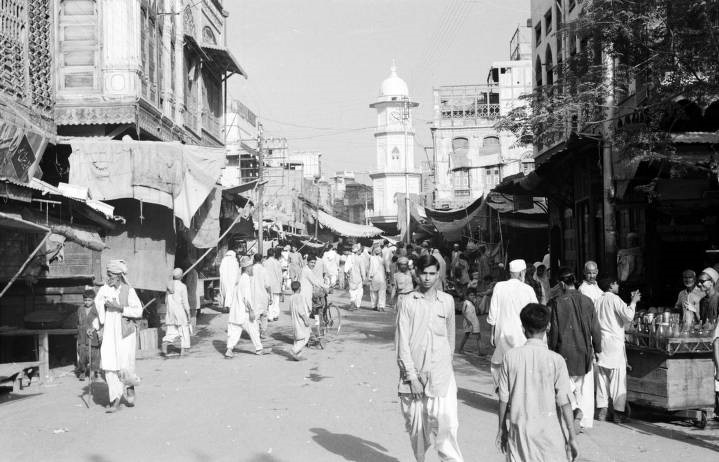Written by: Hidayat Khan
Posted on: August 09, 2021 |  | 中文
| 中文
Ghanta Ghar circa 1900's Postcard photo by Mela Ram and sons
The people of Peshawar could once keep track of time by the tolling of the bell at the historic Cunningham clock tower, commonly referred to as Ghanta Ghar. With innovation in technology and the fast-paced nature of life, people stopped paying attention to the bell. However, the 85 feet tall tower is hard to miss, and catches one’s attention from afar. The government has recently restored and rehabilitated the clock tower as a symbol of Peshawar’s past, and even today the 100-year-old clock and the iron bell tell time with accuracy.
The Cunningham clock tower was erected at the turn of the 20th Century, during the diamond jubilee celebrations of Queen Victoria. The plaque on the building says that its construction was completed in 1900. The tower is named after Sir George Cunningham, then Governor of the North-West Frontier Province (now Khyber Pakhtunkhwa) of British India. It was designed by James Strachan, who was a municipal engineer at the time and designed many buildings in British India, especially in Peshawar and Karachi. According to historians, the construction of the clock tower was funded by the Balmukand family. The family migrated from Peshawar to Amritsar, India after Partition, and currently operate a food company under the brand ‘Clock Tower’ in India.
Located in Baazar-e-Kalan, Cunningham clock tower is surrounded by shops crowded close together, houses and pathways swarming with roadside sellers. Some of these houses are as old as the clock tower itself, and embody the rich history of the area and the lively spirits of its people. In 2003, late Haroon Bilour, who was then serving as the town Nazim, ordered repair work on the tower. He said that the tower symbolizes Peshawar’s past and should hence be preserved. This initiated some rehabilitation work on the clock tower, but since then its upkeep has been inconsistent. The Khyber Pakhtunkhwa government has not carried out archaeological restoration on the structure, because some archaeologists argue that the reconstruction process can tarnish its archaeological value and needs to be handled with skill and special instruments.
Upon entering the clock tower gate, the inner walls are adorned with portraits of Sir George Cunningham and the tower’s designer James Strachan. There are also photographs of Peshawar fire brigade’s old vehicles, and other historic sites of the city. A First World War memorial plaque on the tower reads: “From this city 200 men went to the Great War in 1914 – 1919, of these 7 gave up their lives.”
Peshawar, once known as the city of flowers, has the distinction of being one of the oldest cities in South Asia, and several historical structures in the city tell the story of its glorious past. Not only is the clock tower one of these important historical sites, but it also offers a view of several of these sites. From the top of the tower, the Qila Bala Hissar, the Gor Kathri archaeological complex, the Qissa Khawani Bazaar, the dilapidated ancestral home of Bollywood legend Raj Kapoor, as well as the bustling markets of Peepal Mandi can be seen. In close proximity to the clock tower is the Kabuli gate, that is one of Peshawar’s 16 historical gates. A visit to the clock tower allows a glimpse into each of these places, and their proximity to each other means that they can all be visited in a day’s time.

A market in Peshawar with a view of Cunningham clock tower, picture taken in 1957 by Harrison Forman
To the west of the clock tower is Chowk Yadgar (Remembrance Square), formerly Hasting’s Memorial, another famous landmark in the old walled city of Peshawar. The tower is also part of the first-ever Khyber Pakhtunkhwa heritage trail that starts at the historic Ghanta Ghar and passes through several sites, including Baazar-e-Kalan and the Sethian Mohallah, a once upscale neighborhood of the city which houses seven palatial wooden Havelis built by the Sethis in 1882. The trail culminates at the Gor Kathri archaeological complex, which was used by the Italian mercenary general Paolo Avaitable as his residence during the Sikh rule of the city.
Monuments like the Cunningham clock tower are reminders of a different era. Their presence represents the resilience of the city and its residents through periods of upheaval and change. Efforts to maintain the tower are necessary to keep the city’s connection to its history alive. To leave the tower and other historically significant sites in a state of disrepair is to rob the city of its roots.
You may also like: